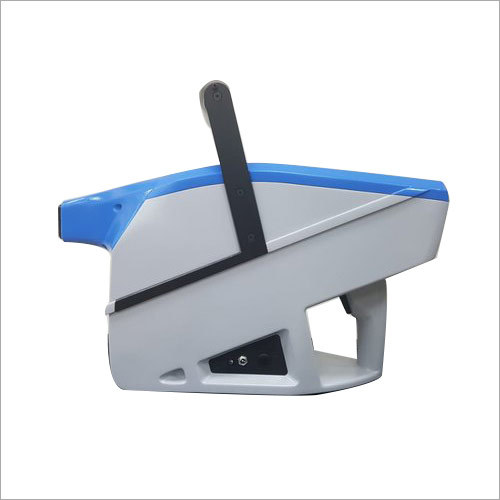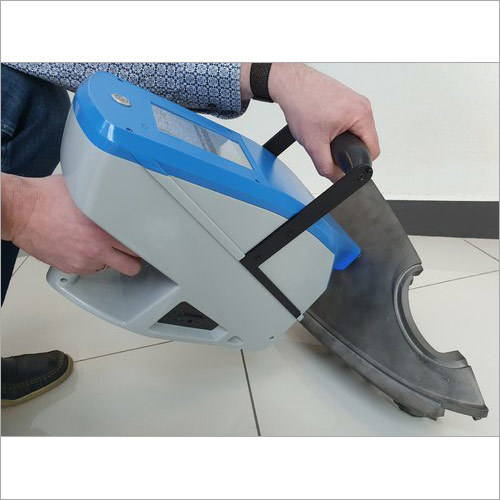Portable Optical Emission Spectrometer
10000 INR/Unit
Product Details:
- Product Type Portable Optical Emission Spectrometer
- Power Supply Battery
- Number of Specimens Single/Multiple
- Port Size Standard
- Frequency 50/60 Hz
- Test Range Wide element ranges (Fe, Cu, Ni, Al, Zn, etc.)
- Humidity 85% RH
- Click to View more
X
Portable Optical Emission Spectrometer Price And Quantity
- 10000 INR/Unit
- 1 Unit
Portable Optical Emission Spectrometer Product Specifications
- Fast
- Metal
- Manual & Automatic
- Handheld
- Flat/Round/Irregular
- Industrial
- 10-40C
- USB, Bluetooth
- Blue & White
- 0.5 MPa
- 0.005% or better (element dependent)
- DC, 12V (via rechargeable battery)
- ppm to % levels, depending on element
- Semi-Automatic
- Portable, lightweight, battery-operated
- High Resolution CMOS Detector
- Digital LCD Screen
- <10 seconds
- Portable Optical Emission Spectrometer
- 200 mm
- Wide element ranges (Fe, Cu, Ni, Al, Zn, etc.)
- 85% RH
- High throughput
- 9 kg
- 50/60 Hz
- 80 mm
- Battery
- Single/Multiple
- Standard
- Portable Optical Emission Spectrometer
- On-site metal analysis
- 80 mm
Portable Optical Emission Spectrometer Trade Information
- 100 Unit Per Week
- 1 Week
Product Description
An portable Optical Emission Spectrometer (OES) is a scientific instrument used to analyze the chemical composition of materials, primarily metals. It works based on the principle of atomic emission spectroscopy. When a material is excited with energy (typically in the form of a high-energy plasma), the atoms in the material emit light at characteristic wavelengths. By measuring the intensity of this emitted light at specific wavelengths, the elemental composition of the material can be determined.
The basic components of an OES typically include:
1. Excitation Source: This can be a high-energy arc or spark generated between an electrode and the sample, or it could be a laser in the case of laser-induced breakdown spectroscopy (LIBS).
2. Optical System: This system collects the emitted light from the excited atoms and directs it towards the spectrometer.
3. Spectrometer: The emitted light is dispersed into its component wavelengths by a diffraction grating or prism. The spectrometer then measures the intensity of the light at specific wavelengths.
4. Detector: A detector, such as a photomultiplier tube (PMT) or charge-coupled device (CCD), measures the intensity of the light at each wavelength.
5. Data Analysis Software: Specialized software is used to analyze the data collected by the detector and determine the elemental composition of the sample.
Portable Optical Emission Spectrometer Specifications:
1. Date Transfer: WIFI and Bluetooth
2. Model Name/Number: LIS-01
3. Material: Metal
4. Working Spectral Range: 177-380 nm
5. Source of Radiation: Pulsed DPSS Laser1064 nm
6. Security: Password Protection
7. Power: Replaceable Li-ion Battery
Applications of Optical Emission Spectrometer:
1. Metallurgy and Metalworking Industries: OES is extensively used in metallurgical industries for quality control, material identification, and compositional analysis of metals and alloys. It helps ensure that materials meet specified standards and regulatory requirements. Applications include analysis of steel, aluminum, copper, titanium, and other metals used in manufacturing processes.
2. Foundries and Casting Operations: OES is used in foundries and casting operations to verify the composition of molten metal before casting. By analyzing the composition, manufacturers can ensure the integrity and quality of cast products, such as automotive components, machinery parts, and structural elements.
3. Mining and Mineral Exploration: OES is employed in mining operations for elemental analysis of ores, minerals, and geological samples. It helps identify the presence and concentration of valuable metals and minerals, aiding in exploration, resource estimation, and ore processing optimization.
4. Environmental Monitoring: OES is utilized in environmental monitoring programs to analyze trace elements and contaminants in soil, water, and air samples. It helps identify pollutants, monitor environmental quality, and assess the impact of industrial activities on ecosystems.
5. Chemical and Petrochemical Industries: OES is used in chemical and petrochemical plants for quality control and analysis of raw materials, intermediate products, and final products. It ensures compliance with regulatory standards, detects impurities, and optimizes manufacturing processes.
6. Aerospace and Defense: OES is employed in aerospace and defense industries for material testing, component analysis, and quality assurance of critical parts, such as aircraft components, engine parts, and missile casings.
7. Automotive Manufacturing: OES is used in automotive manufacturing for quality control of metal components, such as engine blocks, chassis, and suspension parts. It helps ensure the performance, durability, and safety of automotive vehicles.
8. Research and Development: OES is utilized in scientific research and development for studying material properties, investigating new alloys, and exploring novel applications of materials. It provides valuable insights into the behavior of materials under different conditions and helps advance material science and engineering.
Optical Emission Spectrometer FAQ:
Q. What is an Optical Emission Spectrometer (OES)?
Ans: An OES is a scientific instrument used to analyze the elemental composition of materials, particularly metals, based on the principle of atomic emission spectroscopy.
Q. How does an OES work?
Ans: An OES works by exciting the atoms in a sample material with energy (usually through a high-energy plasma or laser). The excited atoms emit light at characteristic wavelengths, which is then analyzed to determine the elemental composition of the material.
Q. What types of samples can be analyzed with OES?
Ans: OES is primarily used to analyze metals and alloys, but it can also be used for other materials, including ceramics, glasses, and minerals.
Q. What elements can be detected with OES?
Ans: OES can detect a wide range of elements, from major constituents to trace elements, depending on the instrument's capabilities. Common elements analyzed include carbon, sulfur, phosphorus, nitrogen, and various metals.
Q. What are the advantages of using OES?
Ans: OES offers rapid analysis, high precision, simultaneous multi-element analysis, and minimal sample preparation requirements. It is non-destructive for most samples and can analyze solid, liquid, and powdered samples.
Q. What are the different excitation sources used in OES?
Ans: Excitation sources in OES include arc/spark excitation, inductively coupled plasma (ICP), and laser-induced breakdown spectroscopy (LIBS).
Q. What factors affect the accuracy and precision of OES measurements?
Ans: Factors such as the quality of the excitation source, optical system efficiency, detector sensitivity, calibration standards, and sample preparation methods can influence the accuracy and precision of OES measurements.
Q. What industries use OES?
Ans: OES is widely used in metallurgy, manufacturing, mining, aerospace, automotive, environmental monitoring, research, and development industries for material analysis, quality control, and research purposes.
Q. How is data from OES analyzed and interpreted?
Ans: Data from OES is typically analyzed using specialized software that compares the intensity of emitted light at specific wavelengths to known calibration standards. The software then calculates the elemental composition of the sample based on these measurements.
Q. What are the typical sample throughput and analysis time for OES?
Ans: Sample throughput and analysis time depend on factors such as sample preparation, instrument configuration, and the number of elements being analyzed. However, OES is known for its relatively fast analysis times compared to other analytical techniques.
High-Performance Optical System
Employing a high-resolution multi-channel CMOS/CCD detector, this spectrometer guarantees precise elemental measurements across a wide range of metals, including Fe, Cu, Ni, Al, and Zn. Fast response times and a broad dynamic range make it ideal for accurate results on-site.
Designed for Versatility and Durability
With protection class IP54, the instrument is robust against dust and splashes, making it suitable for challenging industrial environments. Its compact dimensions and battery-operated feature provide genuine portability while supporting a high throughput of samples.
User-Friendly Operation and Data Management
Featuring digital LCD display, internal memory, and USB/Bluetooth interfaces, data management is streamlined. The device supports both manual and automatic control and is suitable for testing single or multiple specimens, including flat, round, or irregular shapes.
FAQs of Portable Optical Emission Spectrometer:
Q: How does the Portable Optical Emission Spectrometer function for on-site metal analysis?
A: The spectrometer uses arc/spark excitation and a high-resolution CMOS/CCD optical system to detect and quantify elements in ferrous and non-ferrous alloys. Its handheld, battery-operated design allows users to carry out rapid analysis directly on-site, making it ideal for industrial and field operations.Q: What types of samples can the spectrometer analyze?
A: This device can analyze a variety of metallic alloys, including ferrous (steel, cast iron) and non-ferrous (aluminum, copper, nickel, zinc) samples. It accommodates flat, round, and irregular-shaped specimens, making it highly versatile for different industrial needs.Q: When should I recalibrate the spectrometer, and how is calibration performed?
A: The spectrometer features both factory and user calibration options. Recalibration is recommended periodically, particularly when accuracy is critical or if new materials are tested. Calibration can be performed by following the onboard instructions, using reference samples to ensure optimal measurement performance.Q: Where can I export or store measurement data from the spectrometer?
A: Measurement data can be stored internally on the device and exported easily via USB or Bluetooth interfaces. This facilitates straightforward data transfer for further analysis or recordkeeping, whether you are on-site or back at your lab.Q: What is the process for conducting a test with this spectrometer?
A: Testing involves placing the specimen on the port, selecting the desired operating mode (elemental analysis, grade identification, or pass/fail), and initiating the measurement. Results are displayed on the digital LCD in under 10 seconds, ensuring quick quality checks.Q: What benefits does this portable spectrometer offer over traditional benchtop models?
A: The main advantages include portability, rapid response time, and the ability to analyze metals in various environments without needing a fixed installation. This flexibility means users can conduct analysis on-site, reducing downtime and expediting decision-making for industrial applications.Q: How does the device ensure durability and compliance with industrial standards?
A: Constructed from sturdy metal housing and rated IP54 for dust and splash protection, the spectrometer is designed for demanding environments. It complies with ASTM, ISO, and CE standards, ensuring consistent, reliable, and safe operation.Tell us about your requirement

Price:
Quantity
Select Unit
- 50
- 100
- 200
- 250
- 500
- 1000+
Additional detail
Mobile number
Email
 English
English Spanish
Spanish French
French German
German Italian
Italian Chinese (Simplified)
Chinese (Simplified) Japanese
Japanese Korean
Korean Arabic
Arabic Portuguese
Portuguese





